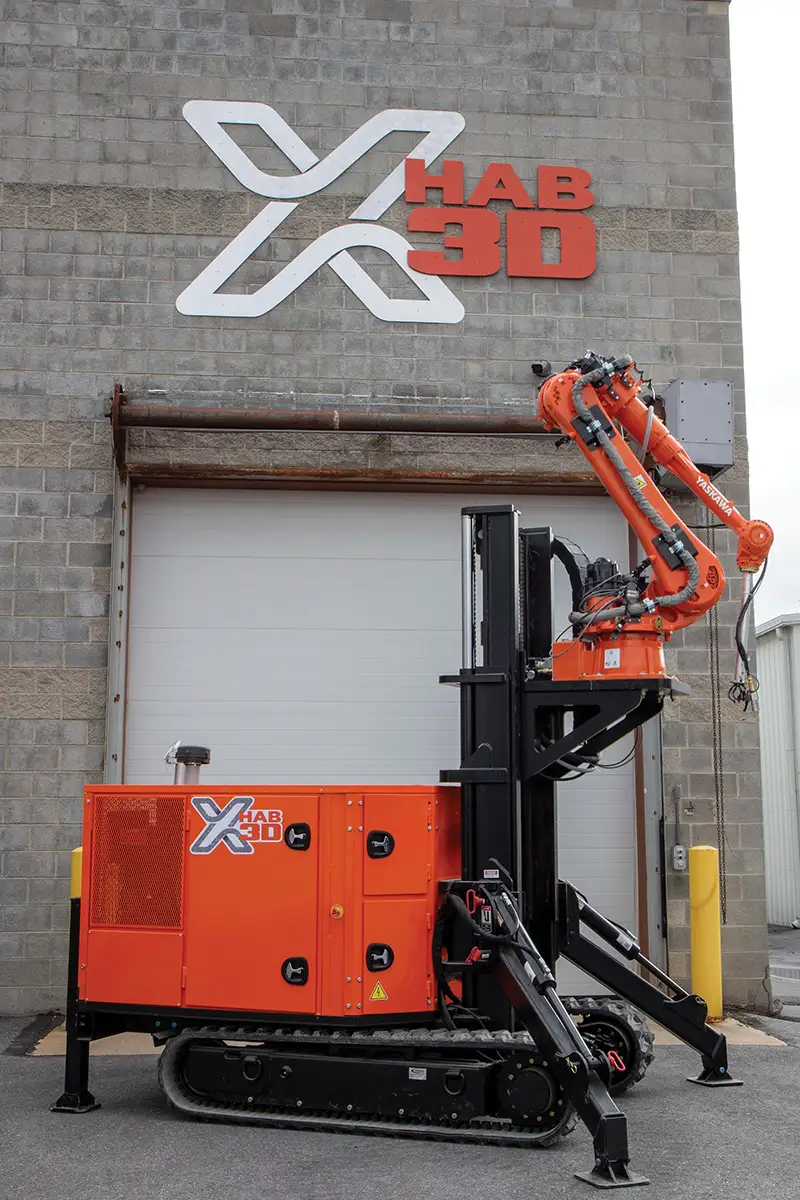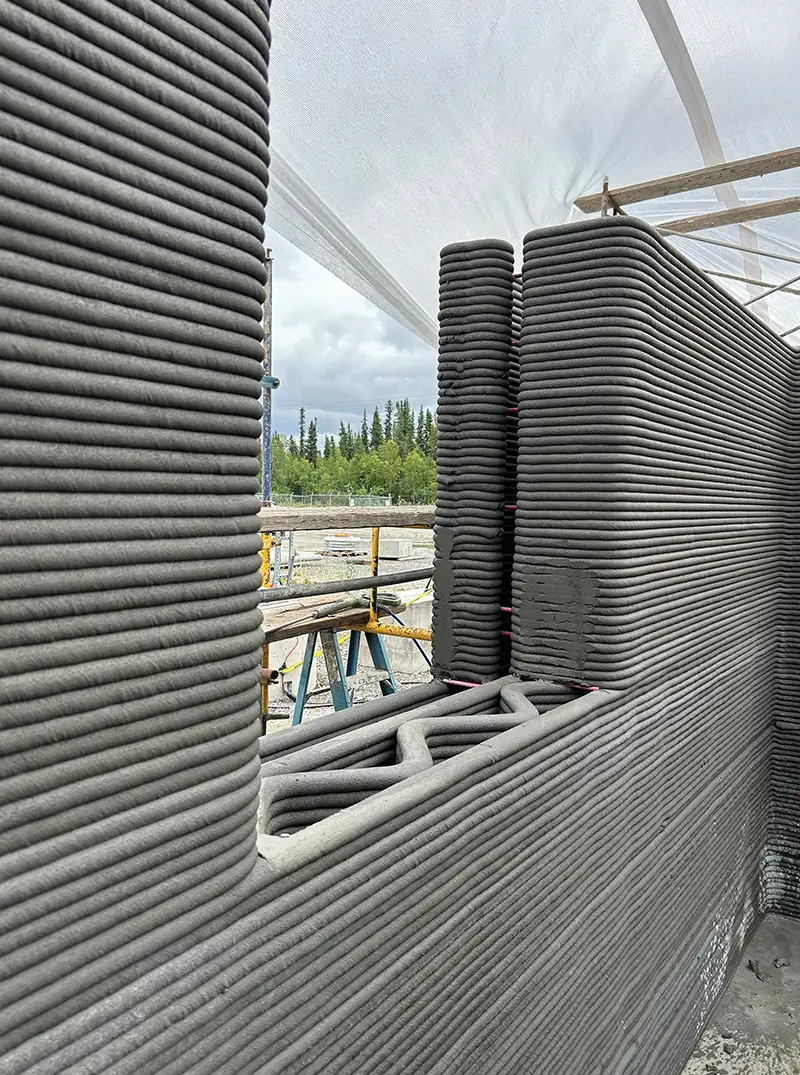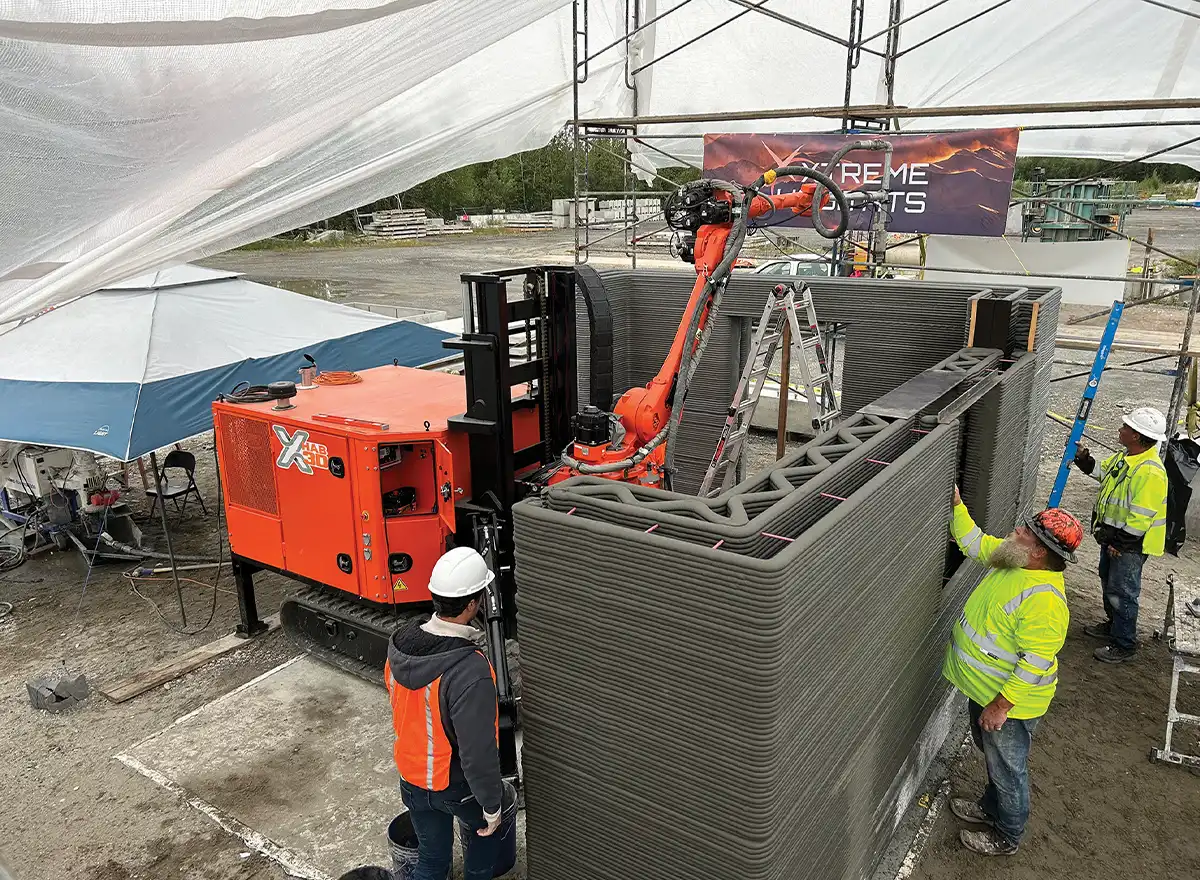n summer 2024, a prototype structure was built in Fairbanks using 3D printing to test whether this technology might work in Alaska. A second project, a 1,200-square-foot home, will be built this summer in Nome to incorporate lessons learned from the Fairbanks building while serving as a further testbed.
“While we’re in the research phase right now, we believe that 3D-printed houses could be cost-effective in the long run, particularly on construction projects in Alaska,” says Sven Bilén, co-founder of X-Hab 3D, a Pennsylvania-based firm that creates robotic additive concrete manufacturing systems, materials, and designs. “Using this technology could help with supply chain difficulties, a shortage of labor, and the short building season, all of which makes housing in Alaska two to three times more expensive than it is in the Lower 48.”
Bilén is part of a team of experts who are working together to study ways that 3D printing can help solve the state’s housing crisis. This team includes UAF, UAA, Pennsylvania State University (Penn State), the Cold Climate Housing Research Center, Xtreme Habitats Institute (XHI), X-Hab 3D, Fairbanks Block and Materials, the Alaska cement masons and plasterers union Local 528, the Innovative Readiness Training Unit of the US Department of Defense, and the National Renewable Energy Laboratory (NREL).
X-Hab 3D
“We need to think bigger, bolder, and more creatively than ever if we want to build the affordable homes of the future,” said Solomon Greene, HUD’s principal deputy assistant secretary for policy development and research, at a 3D printing demonstration held in Fairbanks last July. “This 3D printer is an exciting representation of this new frontier, and we cannot wait to see it at work.”
UAF’s Automated Construction and Advanced Materials (ACAM) Lab, led by Director Nima Farzadnia, who also serves as UAF’s lead investigator on this project, focused on using local resources to make the structure both durable and affordable.
“Our goal is to use locally sourced materials so that, instead of relying on imported commodities from the Lower 48, we can rely on what we have in Alaska,” Farzadnia says. “This can include industrial byproducts, municipal waste, seafood industry byproducts, and even the soil here. We conduct research to develop composites using these local materials enhanced with advanced functions. This could be printability, self-sensing, or self-healing, which are all designed for this harsh environment.”
One of the lab’s goals is to create a product free of portland cement, a material that must be imported from the Lower 48. “Importing construction materials can increase construction costs by up to four times,” Farzadnia explains.
By using automated construction—which can include robotic construction, wireless sensing, or artificial intelligence—ACAM hopes to advance construction methods in the state. Farzadnia notes that robots can also be used for modular construction.
“Robotic construction can play a key role, especially if we merge it with wireless sensors and artificial intelligence, which is how I define automated construction,” he explains. “This could form the future of construction in Alaska, especially in harsh environments. In situ resource utilization (the use of local resources rather than importing them) and automated construction together can provide sustainability and resilience and help keep housing affordable.”
Materials formulated in the lab are tested in cold rooms for their performance at different temperatures, especially severe cold temperatures, for their robustness. In addition to testing the durability, the project includes a lifecycle assessment to determine if 3D-printed construction is less expensive than “stick-built” or conventional construction over the life of the home.
“While we don’t have numbers yet, I anticipate that this method will be cheaper than traditional construction for a number of different reasons,” says Farzadnia. “If the ultimate goal of the project is met, we will reduce the importation of certain building materials, including cement, and we will be able to expedite construction using 3D printers, which is very important with respect to Alaska’s short construction season. Labor construction costs should also be lower.”
According to the Research and Feasibility Study on 3D Printed Homes in Rural Alaska, a July 2021 report prepared by the XHI, the time required to print the outer shell of a 1,200-square-foot house—including foundation, walls, and roof—can be as little as 24 hours versus one to four months for a stick-built house. When multiple houses are required in the same area or village, the 3D printer could build one house after another with significant economies of scale.
The study also noted that building the exterior of a house (i.e., foundation, walls, and roof) in Fairbanks with 3D printing would cost an average of $12.97 per square foot compared to $51.38 per square foot using conventional construction methods.
Farzadnia says that one year of research—from the construction last summer in Fairbanks to next summer—will provide performance data to start the next house in Nome. The team will continue to monitor the Fairbanks structure.

At left, robotics experts in Pennsylvania created the expeditionary printer with the challenges of Alaska construction in mind. Below, the Fairbanks test structure combines materials, design, and workforce development resources in a way never tried in the state before.
X-Hab 3D


A building envelope this size could be printed in a single day. A full-scale house wouldn’t take much longer.
X-Hab 3D
“Bruce and several state economic development entities were talking about different challenges to the economic development of Alaska, including the need to provide affordable housing. When Bruce started looking at ways to crack the nut on this issue, he came across 3D concrete printing and wanted to see if it would work in Alaska,” says Bilén. “He looked around for entities and organizations that might be able to help him and found Penn State through its success as part of NASA’s 3D-Printed Habitat Challenge.”
Penn State has an Additive Construction Lab, and X-Hab 3D is its commercialized spinoff.
Penn State’s initial report, which was sponsored by XHI, noted that this technology was worthy of more investigation and could provide a potential solution to Alaska’s housing problem. From that, XHI approached HUD for funds to take research and development to the next level.
“From there, the project continued to grow,” says Bilén.
X-Hab 3D designs, builds, and sells mobile expeditionary 3D concrete printers, which have a number of advantages over gantry-based printers. The American-made, mobile, robotic arm-type printers can run on their own power in remote areas. The unit resembles a tracked excavator, but the tool at the end of the arm is a concrete extruder. This style of printer can be set up to print quickly, as compared to days of set-up before a gantry-based printer is ready to print.
“These printers can power the concrete pumps themselves, use water from rain barrels, and can move over complex terrains,” says Bilén. “If you think about building homes in more remote areas in Alaska, you need to be able to do it without requiring a power grid or water sources.”
The printers can fit inside CONEX boxes or be transported on flatbed trailers. Once in place, they can print structures up to 22 feet tall.
“The amazing thing is that every building can be printed differently,” adds Bilén. “We have design software that allows us to use different shape parameters, so we can customize houses in different designs all within the same—or different—footprint.”
Bilén notes that 3D printers are already involved in many types of construction projects from residential to commercial, and the military has also expressed an interest in the use of this technology. In 2024, for example, ICON used several gantry-type printers to build 100 houses in Wolf Ranch, a community in Georgetown, Texas, making it the world’s largest 3D-printed community.
“We are definitely building on the experience of collaborators in the Lower 48,” says Farzadnia, who has been working in printed construction for five years and brought the technology with him when he joined UAF.
“While there might have been feasibility studies in Alaska before—I’m not sure—the technology is still pretty new here,” he adds. “And nothing has been done of this caliber, putting together all of these resources in terms of materials design, structural design, workforce development, and more.”
“While there is no one silver bullet to solve the housing problem, this technology is one tool—an important tool—that can help address the issue,” says Bilén. “And it can help not only in Alaska but nationally and globally as well.”
Printed construction is still in its infancy, with materials and techniques evolving in parallel. “The field has made significant advances in the past five years, and it will continue to advance at a rapid pace,” Bilén adds. “I’m excited to see what happens, and I’m looking forward to getting up to Alaska this summer to find ways to provide more quality housing in the state.”